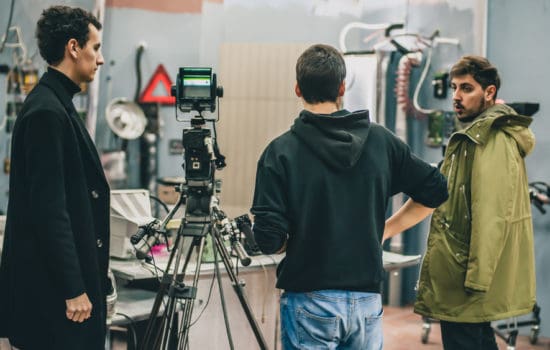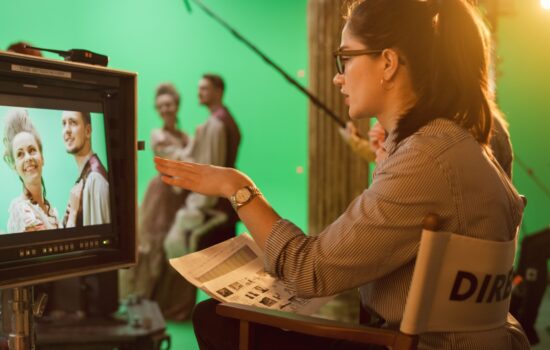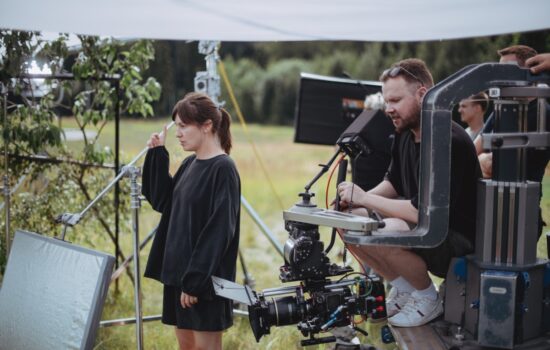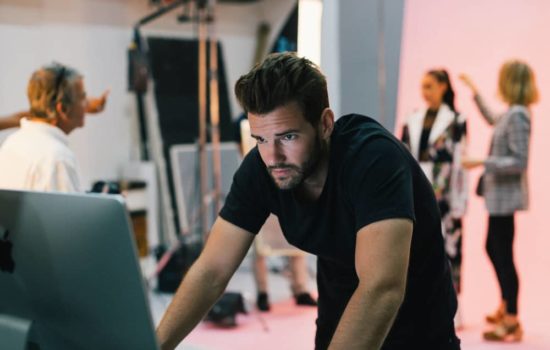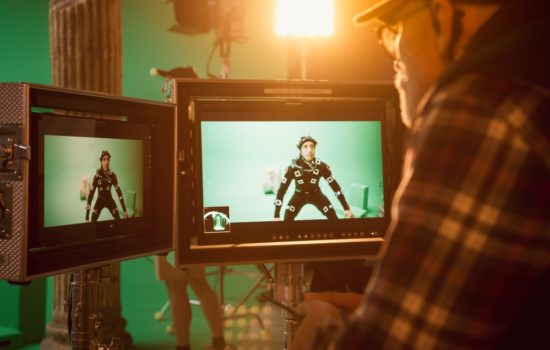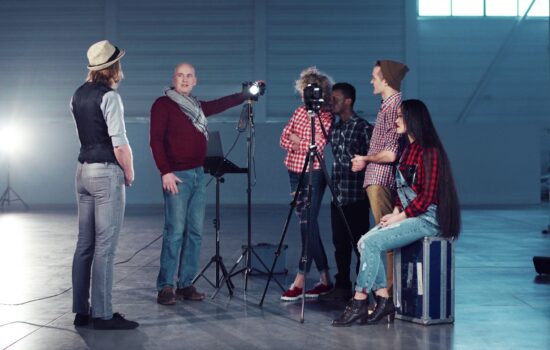Foley Artist
Career Overview
A Foley Artist performs custom-made sound effects for film, television, and other entertainment mediums. Unlike Sound Editors who use pre-recorded sounds to accompany the visuals, Foley Artists create sounds in real-time as they watch the footage to match it.
Alternate Titles
None
Avg. Salary
$450 per 8-hour day

How To Become a Foley Artist
People also ask
Career Description
A Foley Artist creates sounds on a specially designed Foley stage to align with what is being seen on screen. They often work in a team of two Foley Artists and one Mixer, also referred to as a Foley Engineer, in the studio.
The Mixer must understand the goal of each Foley Artist-produced sound and manipulate microphone placements so that they’re clearly and accurately recording the sound needed.
Meanwhile, the Foley Artists perform on stage to create what is needed, whether it’s something as mundane as a pencil tapping against a table or as imaginative as a monster taking a bite out of a skyscraper.
After a Foley session, a Sound Supervisor or Sound Designer will ensure that the sounds captured work with the picture.
Foley is performed live to picture. Foley Artists do not duplicate sounds from a sound effect library. Taking pre-recorded sounds and editing them to fit the visuals of a film is the job of a Sound Editor.
Foley sound takes on a new dimension with content created for distribution in a foreign market, where Actors may dub the dialogue in another language.
In these situations, even if something is recorded well on the production track, if it’s on top of English dialogue, it has to be replaced. This is because once that dialogue track is removed from the final mix, all other sounds will be removed as well.
To learn more about how to become a Foley Artist, we talked to:
- Gregg Barbanell (Breaking Bad, Better Call Saul, The Revenant)
- Alyson Dee Moore (Space Jam: A New Legacy, Star Trek: Picard, Inception)
- Jay Peck (Midsommar, Roma, Succession)
What is a Foley Artist and what do they do?
A Foley Artist is someone who recreates sound effects in sync with the picture. A Foley Artist works on a Foley stage, which is a stage that’s comprised of different surfaces like dirt, wood, cement, sand, and gravel. It’s a sound stage, so it’s very quiet. While the picture is rolling, I mimic what they’re doing on camera. So if someone is running in the dirt in tennis shoes, I’ll have tennis shoes on and I’ll be running in place in front of a microphone and watching the picture.
It’s all synced sound. We don’t pull any sounds from a library. Everything we do is custom for that show. If I do a body fall on one day and the next day they ask for another body fall, I do another body fall. It’s from the old radio days of people doing sound effects. But it’s more visual than it is audio, which would be listening to a script versus seeing what’s happening.
A Foley Artist physically creates sounds in post-production film and television using their body and objects to enhance and or match what is heard on the production sound track. These sounds are the footsteps of the characters, including cats and dogs, etc., and the props they are interacting with.
[The Foley stage is] a recording studio but it’s different from your typical music or V/O studio because built into the floor are all types of different surfaces: cement, gravel, dirt, different types of wood such as boardwalk, solid wood, high-end wood floors, old farmhouse floors, you name it. We have linoleum, smooth concrete, blacktop, street asphalt, and rougher stuff.
There are two basic reasons for Foley. One, even if it’s recorded well on the day, we’re going to do it again because, that way, they’re going to have every single sound isolated and they can control it in the final mix.
The sounds recorded on set are all on one track and it’s focused on the dialogue. In that process, you might hear the feet and the props, etc., but it’s not in the proper perspective and it’s married to the dialogue so there’s no control over levels. Once you perform Foley, if leaves are rustling too loudly, we can lower it because Foley now has the leaves on their own track.
[For the second reason, an M&E (Music and Effects track) in foreign-language versions of a film:] The final mix contains three tracks: a dialogue track, a music track, and a sound effects track. Part of how a show or film makes its money is by marketing the piece all around the world–they have to make foreign language versions.
For those markets, they deliver the mix, drop the dialogue track and send the M&E track only to the various countries. Then, say in Germany, they will record the German dialogue and add it to the M&E.
For the domestic version, Foley allows complete control over every sound. For the foreign version, Foley offers a full M&E track over which they can add their new dialogue.
[The three basic things that Foley Artists record are] “Number one: feet. We see what a character is wearing, what surface they’re walking on and we have to get a shoe that is going to sound right and perform the steps in such a way that it works for their weight and their speed. We also have to inject the character. Are they scared, are they tentative, are they old, are they confident, angry? All these matter when we perform the feet.
It’s a combination of shoe, surface, performance and mic placement so it all blends with the production track. Our job is to deliver a seamless recording that sounds like it was supposed to be there. People shouldn’t “hear” Foley.
We have slight Foley Artists and heavy-set Foley Artists so really it’s an art that revolves around pressure. We have to get the right “character” into the feet; you want to either hit hard or hit medium or hit soft. A good Foley Artist will be able to perform anyone very successfully.
Of course, it doesn’t matter what they look like, it’s all about what they sound like. I may have a woman’s heel that isn’t a woman’s heel at all, it’s a man’s shoe that happens to sound like a stiletto. And I do also have women’s shoes. Does it work, does it fit, do we buy the sound? Those are the tests.
[On to props:] “On the Foley stage is a collection of thousands of items that we surround ourselves with. Piles of metal and plastic and wood and every imaginable prop that might come up. Within reach, we have full kitchen sets, cooking utensils, books, paper, glassware, binders, anything that might appear in a film.
Some sounds are simple enough: putting down a pencil, writing on a piece of paper, setting a coffee cup on a table. These are items where you can actually use the prop you are mimicking.
There are many ways to put a coffee cup down—it might be rim, then base, or it might slide a little or the character might be angry or it might be set down very quietly. That’s why we never use pre-recorded sounds. Our job is to perform it precisely for that scene, with that emotion, with that amount of pressure.
We actually do a cloth pass first, live to picture. Essentially, we sit down with cloth in our lap and we do a complete pass through the whole show of nothing but movement, mimicking the friction of the characters’ clothing.
So, if someone reaches their arm out, you’d hear a little cloth movement there. Or, if they’re walking, you’ll hear a rhythmic pants noise.
But there are far more complex things, sounds that are not everyday.
That’s where we need to get creative and solve a problem. The process is really simple: one, what should that sound like? Two, how do I make the sound I want? Then we actually have to try it out, poke around and experiment a little bit.
For complex sounds like someone driving a car into a building, something we do a lot is “layering”—we’ll make a sound or an element, say a metallic element, then add more of an organic part. Then we’ll add specific taps and we play them all together and it makes that one sound you were looking for.
We can spend hours layering different elements for a car smashing into a building: the wood, the glass, things falling on top of the car, things hitting cement. Then there are science fiction and horror sounds where you’re creating things that don’t really exist. That’s where things get complicated and interesting and fun because you’re coming up with things that will compound the emotion, making sounds that you never hear.
What does a Foley Artist do?
The job of a Foley Artist is to create a sound that will be used for a film. That sound can be almost any everyday noise, such as a footstep in the snow or a wine glass breaking on a tile floor, but a Foley Artist must be prepared to create nearly any sound required for a film.
Salary
The annual salary of a Foley Artist depends on multiple factors.
For one, the nature of the project they’re working on. A small indie film will likely have a smaller overall budget to work with, in comparison to a studio-backed feature. As a result, the pay for the Foley Artist will also be smaller.
Two, the number of projects a Foley Artist can work on in a given year. This particular field is highly competitive, which means that jobs can be scarce. That often translates into a lower overall annual salary.
And three, the Foley Artist’s union membership or lack thereof.
Foley Artists belong to the Motion Picture Editors Guild, also known as the IATSE Local 700. Union membership means guaranteed minimum rates that productions must pay their Foley Artists. Though the type of production will still affect the overall rate, a Foley Artist can make approximately $400-450 per day on a union project.
In comparison, a non-union Foley Artist might make $200 a day. It all depends on what the Foley Artists themselves can negotiate for their daily rate on that project.
Because of these multiple factors, it’s challenging to discern what a Foley Artist, union or not, might make as an annual salary.
How much does a Foley Artist make a year?
I think the minimum in the union is $440 a day. It can go up from there. Not a lot of people make that much more over that. There are a handful of people who make over $1,000 a day, but that’s very unusual. I guess you could potentially make that, but I think the days are over where they’re going to be paying that kind of money. I would say $450 is about your average eight-hour day. In the union, it’s any five days in a row. We could be Thursday, Friday, Saturday, Sunday, Monday and you don’t have any overtime on the weekend because that’s your schedule. It can get a little tricky.
We finally have a classification in the union. I don’t know if those numbers are there for the public, but that’s what the minimum is: about $440. It’s like an hourly rate, but it’s an eight-hour minimum. Again, it can vary. If you’re not in the union, they can pay you whatever they want. They can pay you $400. That’s why it’s better if you can get paid through the union. You want the union hours. I think there’s less being taken advantage of. A lot of people will just work until they get the show done. Maybe it takes them twelve hours but they’ll only get paid for eight. They’re working for free. I’m so against working for free.
It is hard to predict how much money a Foley Artist can make in a year as the business is very unpredictable. Once you become proficient and find work with an established post sound facility you can make a very good wage.
Foley Artists are independent so you have to negotiate your fee on each job. The union does guarantee minimums, but unless you’re working regularly, it’s a hard road–you have to be ready to go down that path.
How much does a Foley Artist make?
Foley Artists are nearly always independent contractors who often can set their own work rates. In general, this rate falls between $400 and $450 per day. That being said, that rate may be lower for newer Foley Artists. How that rate stacks up over the course of a year also depends on how often a Foley Artist works. In many cases, it can be a very unstable career with lulls between gigs, as well as periods of extremely busy days.
Hey, what do you think about trying our new Film Career HelperFilm Career Helper really quick? It’s totally free and could help get your career moving fast! Give it a try. It’s totally free and you have nothing to lose.
Career Outlook
As mentioned, the life of a Foley Artist can be a competitive one. Many Foley Artists stay active for decades with longstanding professional relationships that afford frequent work, which can make it all the more difficult for an aspiring Foley Artist to break into the industry.
That being said, someone who is passionate about the craft and dedicated to making it their life’s work can forge a career as a Foley Artist.
While a significant part of this career is cultivating the skills to be a proficient Foley Artist, they also need to continually be nurturing the professional relationships that will lead to future jobs. As a result, the life of a Foley Artist means constantly hustling for the next gig.
The future of entertainment continues to evolve with options for Foley Artists to work in mediums such as streaming content, so in some ways, there are more opportunities for jobs.
That being said, many of these mediums do not work with union members, which means that the overall rate for a Foley Artist’s work might be significantly lower.
In turn, a Foley Artist may have to work harder to secure the next job to ensure that their overall annual salary affords them a comfortable living wage. This might mean working other types of industry jobs as well to supplement that salary.
These considerations aside, the professional life of a Foley Artist can be highly creative and rewarding. Foley Artists play an important role in bringing to life a film through sound, and because of their specialized skills, they contribute in a way that many other creatives cannot.
Is it hard to become a Foley Artist?
It can be difficult to find the right situation that can offer the opportunity for someone to intern or apprentice. Once you have the opportunity to start performing Foley it takes a lot of hard work, practice, and concentration to develop a good touch in the recording process.
It’s very hard to get into Foley. There’s no training. Some schools have Foley stages and maybe you can have a class on Foley. But Foley Artists never retire. There’s a Foley Artist now who’s eighty and she still works. Her daughter is now a Foley Artist. Lots of daughters and sons became Foley Artists from their parents.
The best way, I’d say, if you want to be a Foley Artist is to study sound and sound effects. Get a job at a low-budget sound house; wherever you can get a job that’s a post-production facility. Go in that way and find out who does their Foley. Ask if it’s okay for you to get a hold of a Foley Artist, or ask the Foley Artist, “Is it possible that I can come by and meet you and maybe watch for half an hour?” That’s the best way to go about it.
Foley Artists can be really temperamental. But if you can get a hold of a Foley Artist through a post-production house–that’s probably the best way of finding a Foley Artist–and then call and just ask if you could come by and meet them and maybe take them to lunch or watch them for half an hour. I think that’s the best way to go about it.
You might find some people are very open to it, others might not be, just because with Foley, we’re in a union. But there are a lot of non-union houses out there and a lot of under-bidding. The average for a Foley Artist is about $450 a day. It’s all a daily rate. If you’re doing that and not getting paid through the union, it’s a 1099 situation where you have to pay taxes. There’s no unemployment.
Lots of people will come and say, “I’ll do it for $250,” because that’s a lot of money, but you have to respect the history of who’s been doing it. A lot of people say, “You have experience.” That’s true, but sometimes they just don’t care and they’ll hire someone who’s not so good just because they need something, some kind of sound.
What is the work lifestyle of a Foley Artist?
You’re standing all day, pushing car doors around, lifting heavy metal, getting up and down off the floor. And when you’re rolling, every muscle is fired and ready to react. Eight hours of that is enough! On top of that, there are no Assistants to clear up our mess–I wish we had them! It’s just two Foley Artists smashing glasses, concrete, everything, so there’s a ton of mess.
We’re now asked to do an awful lot in very little time–the number one challenge is the clock. We have to make a lot of decisions–do we have time to do this prop or these background feet?
If we can get overtime approval, then we will, but if we can’t, we have to do the best we can with the time we have. Time management is such an important part of what we do. Being creative takes time–you have to try this, try that–and it’s time-consuming.
Some shows give you lots of time. I did all of Breaking Bad and they gave us a tremendous amount of time, two and half days on average per episode, and you can tell. Everything is precision done and they used all of our Foley. But that’s a luxury.
[Now, at Universal,] we basically have eight hours to do everything. So you just can’t compare the shows because we had three times more time on Breaking Bad.
We used to have twenty days to do a film. These days you’re lucky if you get ten. Obviously, bigger A pictures give you more time, but the majority have a rapid turnaround.
I don’t buy the traditional feature/television hierarchy that some Foley Artists subscribe to. It’s a fallacy that you have to be doing feature films to be considered a quality Foley Artist.
I sleep to maintain work/life balance!
Who is a famous Foley Artist?
Perhaps the most famous Foley Artist is the individual for whom the profession was named: Jack Foley. Though Foley Artists can be indispensable to the creation of the audio landscape for a film, the individuals who create those sounds rarely are known outside the film industry.
Career Path
There is no one clear path to becoming a Foley Artist, which can be liberating for some people and disappointing for others to hear.
However, because of its role in the world of entertainment, some aspiring Foley Artists may begin their careers with film school where they can become better versed in how sound impacts storytelling. Depending on the program, they may even be able to work on Foley sound stages and get real-world experience as a Foley Artist on student films.
Whether they kick off their careers in film school or not, aspiring Foley Artists should look to any sound-centric opportunities as they build their skillsets, resumes, and professional networks.
That might mean working as a Production Assistant on set, perhaps as part of the Sound Department, or looking for an internship or other entry-level position in a post-production company where they can work with sound professionals.
Mentorship with an established Foley Artist can be a fantastic way to learn the ropes and observe how a professional works. That being said, it can be challenging to forge a relationship with someone who is willing to be that mentor.
It never hurts to ask, though! Through professional sites like IMDB Pro or local post-production houses in your area, you can always reach out to see if you can connect with a Foley Artist or perhaps get a job with one.
As an aspiring Foley Artist begins to build their knowledge and expertise in the post-sound world, as well as grow their professional connections, more opportunities will come where they can finally step into the role of a Foley Artist.
How do you become a Foley Artist?
There is no specific way or class that I know of teaching Foley. I think the best way is to find a facility that has a Foley studio and apprentice under someone that has thorough experience working in the field and the need for assistance.
I was a Sound Editor with my own editorial company in the ‘80s, and we did the complete sound editing package. I ended up getting on the Foley stage and it turned out I had a gift for it and performed all our Foley. When I sold the company, I was trying to figure out my next step and my phone started ringing from my competitors and they asked me to do their Foley. And I did. And I’m still here, still trying to figure out what to do next! I have a job and I wake up very happy to be doing it.
[Contact current Foley Artists and ask] “Would you let me stop by and spend an afternoon just watching you at work?” Tell them you won’t get in the way, and then it’s up to you to ingratiate yourself to the people and, hopefully, come back and do it again. If they like you, they might invite you to come back in and try cueing a session. [Cueing is when you make a list of the Foley sounds that are needed in a ProTools session.]
There are hundreds of Foley Artists in town these days and there’s only so much work so it gets competitive. Really, it’s a highly specialist art form, especially as shows and features are beginning to digitize Foley. It sounds like crap, it’s very robotic, but it does happen. The human element that Foley brings is beautiful and necessary.
I’m lucky having worked pretty much non-stop for forty years. I have around 565 credits on IMDB–it’s insane. I look at that and think, “How the hell did I do all of this?” Well, I never say no, and that’s my reputation. I do independent projects all the time; I squeeze them in. I’m happy working on projects of all sizes and I get called all the time to do smaller things.
If you talk to any Foley Artist, everyone has a different path. Foley really is a new career. It’s only been a career since about the mid to late ‘70s. Before that, Sound Effects Editors would do their own Foley, but they would call it “syncing.”
Let’s back up. It’s called Foley because the man who created it is called Jack Foley. He was a jack of all trades. He did a little bit of this and a little bit of that, and one of the things that he did was–I think it was for Spartacus–a scene with a chariot race. The Director was saying, “I didn’t get the sound I wanted out of the armor. I’m going to have to re-shoot that whole scene.” He said, “Give me a minute.” He went home and got some pots and pans and keys and clanked them around, went on the stage and said, “Let me try something.” He made all the sound effects while they rolled the picture and that’s really how it became [a trade].
He was the first to do sync to sound. He built a little stage and they’d say: “I’m going to go do my syncing on Foley’s stage.” That’s how it became a Foley stage. He never lived to see us become Foley Artists. His granddaughter isn’t in the business, but we talk to her quite often about him. She’s thrilled. She said he would have been thrilled to find out that something was named after him.
These Sound Editors, these guys–because they were all guys, of course–would go to the stage and they’d bring a bucket of beer and they’d sit down and do the sound effect thing for the reels. There was a guy named Ross Taylor, and he was really good at it. They’d say to Ross, “Hey, I’ll buy you a six-pack if you do my reel,” and that’s where he really honed it and started doing it as a living.
He met this Dancer named Kitty Malone. They would hire Dancers at the time to come in and redo Dancer footsteps because their sync was so good. They knew a routine and they could just do it. Kitty was really, really good at it and they teamed up. They were the very first Foley team and were also a couple.
There’s a book called The Foley Grail by a woman named Vanessa Ament. She was a Professor and she wrote a book about Foley. If you’ve seen the documentary Making Waves, which is a documentary about sound, I believe Kitty is in that one as well.
Experience & Skills
The job of a Foley Artist is to create sounds to fit the narrative and world of a film. In general, that breaks down to recreating movements, footsteps, and prop sounds.
In some cases, it can be straightforward, as in walking across a room to recreate footsteps. But in other cases, they may have to get quite imaginative, as with figuring out how to create the sound of a monster biting into a skyscraper.
That’s why ingenuity and imagination are two significant skills that a Foley Artist must have for the job. Also, patience and experimentation.
The first try at creating a sound might not work. It may take multiple takes, each with slightly different motions or equipment used, to get that sound just right. For a Foley Artist, this is a regular part of the job.
Experience comes from not only professional gigs, but also personal trial and error.
Foley Artists must have a curiosity and passion for creating sounds that go far beyond just working on their craft on the Foley stage. Constantly experimenting with both movements and props to discern what sounds can be made from them will help once they are on that Foley stage and need to create the appropriate sound.
Like most other roles in entertainment, that of a Foley Artist is one of collaboration. Especially when working directly with other Foley Artists, a professional in this field must have an affinity for being open to others’ ideas and knowing how to communicate effectively with them.
In general, great communication skills are also key for developing professional relationships and building a network that will help with getting jobs in the future.
What skills does a Foley Artist need?
If you think you might be good at it, switch on your TV at home and turn the sound off. Put on a pair of firm shoes and stand on a wood or tile floor (not carpet). Then, you literally stand there and as people are walking around, see if you can match their steps.
Props are a little easier, but what really separates the cream from the milk is footsteps. If you find that you can synch footsteps perfectly, stop when they stop, catch that weird hitch in their walk, most people can’t do that and that’s a brilliant start.
Then you have to layer in the subtleties, the softness, the emotion, the ability to stop and shuffle and get that twist of the foot and knowing that when you start to walk your pressure starts slowly and then as you gain speed, you start to hit a little bit harder…these are all things that you learn over time. If you want to see if you’ve got what it takes, experiment with the television.
[Like musicians] anyone can learn to play, but that doesn’t mean you’re great. It’s something inherent, built-in, and it’ll take years to find out.
It’s a team effort. You want to be open to suggestions and collaborations so when someone asks you to try something a different way, you have to be ready for that. You need to be collaborative in that way.
Education & Training
An aspiring Foley Artist does not need a film school degree to get into this line of work.
However, film school can be a great place to start your career. As mentioned, it’s in film school where an aspiring Foley Artist can better understand and learn the role of sound in movies and perhaps get early experience on a Foley stage.
A general education in sound or music can also give an aspiring Foley Artist a firm foundation for the rest of their career. While in school, they can also begin forging those professional relationships that can prove invaluable down the road.
Outside of formal education, an aspiring Foley Artist will absolutely need real-world experience in post-production sound to build their skillsets and reputation as a solid professional in this particular field.
That means taking on any sound-related job that could help in building those skillsets. On-set gigs can initially prove useful, but if there’s an opportunity to work in a post-production sound facility, someone looking to become a Foley Artist should take it.
As an aspiring Foley Artist begins to grow their resume of work and professional contacts, more legitimate Foley gigs will become available. That might mean smaller projects such as an indie film or streaming show that could eventually translate into more high-profile productions like a studio-backed feature or network television show.
Do you need a degree to be a Foley Artist?
You do not need a degree to become a Foley Artist. I don’t think there are any schools that offer that. You can get a degree in filmmaking and may have the opportunity there to work on student films, however.
There are some schools that have dedicated Foley stages. I teach masterclasses at the Dodge College of Film and Media Arts at Chapman University; their Foley stage is professional quality, it’s remarkable. They offer a Foley class and you can learn to do your own Foley on the stage. There are other schools with facilities but, in the majority of cases, the stages are horribly low-tech.
Foley is the last of the low-tech arts in filmmaking. We’re still doing things the same way the radio sound effect artists were doing it in the ‘30s and ‘40s.
Getting trained in sound editing or post-production is good. I know Warner Brothers, when they had their Y16 program–which is the entry-level union position–the guy that would hire would only hire people who were in the sound program. He didn’t want people in there being like, “I don’t know what I want to do.” He wanted serious people who were going to come in and weren’t going to be in Y16 for a long time. They were going to find their path.
There are so many jobs in post-production sound. There are Sound Effects Editors, Dialogue Editors, Music Editors, ADR Editors, Sound Supervisors, Post-Production Supervisors, there are Mixers, there are ADR Mixers, Foley Mixers, and Dubbing Mixers. There’s a huge array of Assistants. People who are Sound Assistants, that’s a career for them because they’re so good at it.
You want to get in the union as soon as you can so that you can get your hours and get your medical. They’ve got the best medical plan. There’s a great pension. But we weren’t even unionized until 2005, and I’ve been doing Foley for forty years. I wish I had been in forty years ago as a Sound Editor but I wasn’t. I just got in in 2005.
If someone says to you, “Hey, do you want to come work here as an Apprentice or as my Personal Assistant?” take it. That’s how I got in. I was the Sound Editor’s Personal Assistant. I think that if you have an opportunity over education, I would take the opportunity, because education’s not required. The experience is what’s required.
The best advice I give to everybody is, just be nice to everyone and be appropriate. Pay attention. Don’t be on your phone. Show that you have an interest in it because people will pick up on that right away. And as you know, people want to be around people who are pleasant.
Fun Facts
Foley Artists often use highly unusual materials to create sounds, such as crunching celery for breaking bones or knocking together coconut shells for a horse’s footsteps!
Additional Resources
Both for networking and building one’s expertise in Foley, the internet can be a valuable resource for an aspiring Foley Artist.
Sites like MasterClass and YouTube offer articles and tutorials on the craft. Social channels like Facebook and Twitter also allow aspiring Foley Artists to connect with others who are interested in sound design.
Even if an aspiring Foley Artist isn’t yet part of the Motion Picture Editor’s Guild, it’s never too soon to find out about its benefits. Barbanell advises, “You have to have a union gig in order to join the union and then you have to report around 400 hours bi-annually to keep your health benefits. It’s a tough one if you’re not working regularly, but the healthcare is excellent if you’re managing to clock the hours.”
Foley Artists may also take advantage of events through their union to connect with other Foley professionals.
Let’s take a look at some of the most outstanding use of foley work through some landmark motion pictures…
- Jurassic Park – Kitchen Scene
- No Country For Old Men – Moss In The Motel Room
- Alien – Ripley Discovers The Alien
- Avatar – The Final Battle
- Wall-E – Opening
- Psycho – The Shower Scene
By now, we’re all (hopefully) familiar with JURASSIC PARK, a movie that brought dinosaurs back to life. In the film’s third act, when the velociraptors have cornered the kids in the kitchen, sound (read: foley work) plays an instrumental part in creating the tension and suspense that pervades the sequence. From the noises of the kids’ footsteps to the clinking of the utensils to the breathing and claw tapping of the dinosaurs themselves, the scene plays like a masterclass in sound supporting visuals and story. The work is expertly crafted to immerse the audience into the harrowing experience right along with the children on screen and the scene is infinitely more memorable because of its sound design.
The Coen brothers’ masterpiece NO COUNTRY FOR OLD MEN is a shining example of filmmaking at its purest level. As the film’s hero Moss awaits a killer approaching his room, the subdued but brilliant foley work plays a key role in ratcheting the film’s intensity. Using minimalist visuals and sounds, the sibling filmmakers created an expertly-crafted sequence that dares the audience to breathe as it builds to a stunning climax.
Ridley Scott’s groundbreaking science fiction/horror film ALIEN raised the bar for suspense and tension in both genres. In this scene, the film’s climax (warning: spoilers!), all but one member of an exploratory space crew are dead, having been killed by an unstoppable alien species. At the movie’s end, Ripley, the lone survivor finds herself in the same space as the creature. To her luck, the beast happens to be sleeping. Watch the scene and pay particular attention to the way sound is imbedded into the sequence, moving it along both narratively and emotionally.
James Cameron’s AVATAR reshaped the cinematic landscape in terms of aesthetics and audio when it first graced the big screen in 2009. The story of an Earth soldier who goes to a far-off planet, meets a native tribe, and soon becomes one of them set new standards for filmmaking. In the film’s climax, an epic battle is joined through the skies of the planet Pandora, as the heroes do battle on flying creatures called Ikran against the machinery of the enemy. Watch some of the sequence and discover how sound couples with visuals to truly elevate the filmic storytelling.
Wall-e is Pixar’s animated story of a robot tasked with cleaning up trash on a ruined, debris-covered Earth. Much of the opening of the film’s exposition is spelled out not through dialogue, but rather images coupled with excellently-crafted foley work. In this clip, notice how sound plays a crucial role in building this world and creating a bedrock for the movie’s narrative. And while the images can speak for themselves, the sequence itself would be far less impactful had it been missing sound.
The landmark shower scene from Alfred Hitchcock’s signature film PSYCHO set a new precedent for the way movies are made and not just watched, but experienced. In the film, protagonist Marion Crane has made off with some stolen money. She stops at a motel, speaks with the proprietor, and then takes a shower where she meets a terrifying end when a knife-wielding maniac enters the bathroom. Hitchcock and his sound team experimented with microphone placement that created a new sense of immersion for the audience. The stabbing sound of the knife is particularly noteworthy, as even though we hear it, we never see the blade cutting skin. It’s all imagination and foley work.
FAQ
What is the single biggest suggestion you would give to someone wanting to get into this career?
“Turn on the television, mute the volume, put on some firm shoes and practice synching your footsteps to the picture. If you can do that after a few tries, you might have something.”
Anything else that you think people who are interested in Foley should know about?
There are a couple of small things you can watch. My partner and I did one of us doing Foley sound for the weather, which was fun. There’s another one that the BBC just did on me which is kind of interesting. They’re not very long. They’re like three minutes long. I don’t know if you saw the one … it’s the two British Foley Artists doing Foley for a show with a boat and a fishing dock. It’s so beautifully done. It’s probably, I think, one of the best things done about Foley. It’s really a fun thing to watch.
Don’t be afraid to get a job in something that you think you have no interest in, because you never know where that’s going to lead. Our now-retired Mixer, her Recordist was a Security Guard at Warner Brothers. He met her and asked if he could sit in and watch, and then he became a Recordist.
That’s not a normal path. Warner Brothers have a really great tour and they’re hiring Tour Guides all the time. It’s different from being a Tour Guide at Universal, just because that’s more of a theme park. Warner is a really good tour because it’s a working studio. I say be a Tour Guide. Just get in. You’re around people, and sometimes they go to the Foley stage. You just never know where the opportunity is going to be.
What’s the #1 mistake people make when trying to get into this career?
“Younger people come in and dramatically undercut their rate to get the gig. That really upsets people and it undervalues you. Find out what people are getting and ask for the same thing. Sure, drop it by twenty bucks, but don’t do anything silly by cutting it in half. That gets everyone in hot water.”
What is the question people should ask about this career but rarely do?
“Is this for me? You have to ask yourself that question. But if it is, if you love it, jump right in!”
If you could describe in one word what makes you successful, what would it be?
“Tenacity. Just keep plugging away. I wouldn’t sit idly — poke around and find out what people have got coming up.”
Sources

Gregg Barbanell
Gregg Barbanell gained a BFA in Film from the California Institute of the Arts, then went on to own and run Mag City Inc. between 1979 and 1986, a major post-production sound company, before joining the team at American Zoetrope.
Barbanell has won an Emmy Award and has been Emmy-nominated 10 times. On top of that, he has 8 Golden Reel Award wins and 29 nominations to his name. His decades-long career has garnered him an unprecedented 564 credits on IMDb. For a quick walk-through of a Foley stage, check out this video where Barbanell takes us behind-the-scenes on the Warner Bros. lot.
His foley career has been featured in CineMontage, The Early Call Time podcast, the documentary Actors of Sound, Priceonomics, the Jon of All Trades podcast, Monster Children, the Turned Up: Reel Sound podcast, Adobe’s blog, and Virginia Loh-Hagan’s book Sound Effects Artist.
Barbanell’s recent nominations for the Emmy Awards and the MPSE Golden Reel Award were mentioned in Variety, Deadline, Awards Daily, Mix Online, Yahoo.com, Pro Sound Network, and Animation Magazine.
Barbanell won the Golden Reel Award for his work on Breaking Bad.
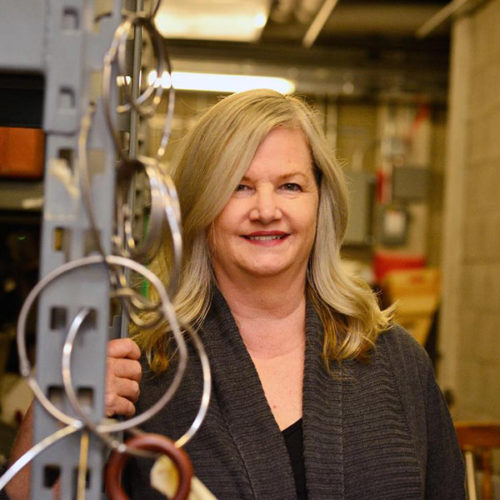
Alyson Dee Moore
Alyson is a native Southern Californian and started her film career at the age of eight as an Actor. When she was ten, Alyson had the opportunity to be a newscaster on a local television show called TLC Elementary School (1995) which had a three year run. Her father was a character Actor (he played Hank Kimball on Green Acres (1965)) who also produced a film called A Boy and His Dog (1975). Growing up around film and television, Alyson always knew that she wanted to work on a studio lot. After high school, she started working for a Sound Editor and “fell” into Foley. Thirty years, one Emmy Award and countless MPSE awards and nominations later Alyson is living her dream and has been working at Warner Bros. Studios for the past 15 years.

Jay Peck
In 1997 Jay Peck segued from scoring and performing live sound effects and percussion for New York theater productions (Mabou Mines’ Peter & Wendy, Landscapes, Animal Magnetism) and recording and touring on drums with rock bands, (Figures, Lets Active) to foley walking at C5, Inc. From there he went on to freelance at many of the post-production studios in New York City before becoming the resident Foley Artist at Sound One, Inc. for nine years until the company closed its doors unexpectedly in 2012. After an exhaustive search and more than a little help from his friends, he founded Stepping Stone Foley studio at its current location in December 2012.
